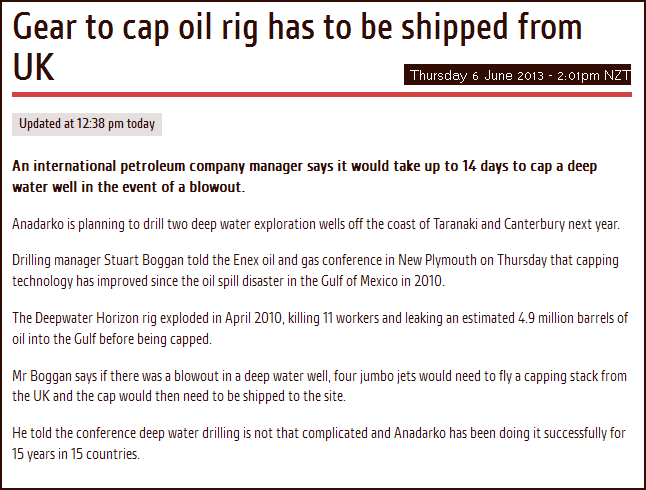.

.
The stats;
Event: Deepwater Horizon drilling rig explosion & oil spill
Date: 20 April 2010
Human death toll: 11
Animal death toll: unknown
Est. Oil Spilled: 4.9 million barrels of oil
Depth of water: 1,500 metres
Depth of well: 10,680 metres
Time to cap oil spill: 87 days
An international petroleum drilling expert, Stuart Boggan, has advised an oil and gas conference in New Plymouth that capping an oil blow-out, similar to the disaster in the Gulf of Mexico in 2010, would take two weeks;
.
Acknowledgment – Radio NZ – Gear to cap oil rig has to be shipped from
.
Two weeks.
Assuming that a similar disaster occurs here, of the east coast of New Zealand, at the Raukumara Basin – which is deeper than the Gulf of Mexico – how much oil could be released in those two weeks?
A simple bit of math: 4.9 million barrels divided by 87 days equals: 56,322 (approx) barrels per day.
At 56,322 barrels per day, that would see 788,500 barrels over two weeks.
One barrel of oil is equivalent to 158.9 litres (approx).
788,500 barrels equates to 125,292,650 litres. One hundred and twenty five million litres.
By comparison, the oil spill from the grounding of the M.V. Rena on 5 October 2011 released 1,800 litres (1,700 tonnes) of heavy fuel oil and a further 213 litres (200 tonnes) * of marine diesel into the sea (see: Rena ‘worst maritime environmental disaster’);
.
Acknowledgment – The Guardian – New Zealand oil spill – in pictures
.
The oil spill affected a coastline from Mt Maunganui to Maketu – and further beyond;
.
Acknowledgment – BBC – Salvage crew returns to New Zealand oil spill ship
.
It took hundreds of volunteers several weeks and months to clean up a mess caused by “only” 2,013 litres of oil and diesel.
Now imagine the horror of 125 million litres gushing from a deep-sea well at the Raukumara Basin that could be five to six times deeper than the position of the Deepwater Horizon rig.
Remember the the depth of water at the rig was around 1,200 to 1,500 metres.
The Raukumara Basin in some areas extend to over 6,000 metres (6 kilometres) in depth;
.
Source: Ministry of Economic Development – Raukumara Basin Fact File [699 kB PDF]
.
When, on 24 October 2012, Prime Minister John Key was challenged in Parliament over the safety of deep sea drilling, this was the exchange,
Questions for oral answer
5. Oil and Gas Exploration—Deep-sea Oil-drilling and Environmental Risk
5. Dr RUSSEL NORMAN (Co-Leader—Green) to the Prime Minister: Does he stand by his statement, “We’re not environmental bandits. If we don’t believe drilling can take place in a way that is environmentally sustainable and wouldn’t put at undue risk the environment, we wouldn’t go with it.”; if so, why?
Rt Hon JOHN KEY (Prime Minister) : I stand by my full statement, which included that we want to balance our economic opportunities with our environmental responsibilities; because it is true.
Dr Russel Norman: How is deep-sea drilling not putting the environment at undue risk, when just this month Dayne Maxwell of Maritime New Zealand said about the Government’s oil response equipment: “Most of the response equipment that we have is designed for near-shore sheltered conditions, and really there isn’t available internationally any equipment specifically designed to operate in the rough kind of conditions offshore that we have in New Zealand.”?
Rt Hon JOHN KEY: Well, that is one person’s view. I think it is also worth remembering that if somebody gets a permit to go and undertake these activities in the exclusive economic zone, not only would this Government be filling a gap that was previously left open but also there would no doubt be conditions on that. Finally, as I said yesterday, there have been 50,000 wells drilled in the Gulf of Mexico. Is the member arguing that all of those wells were a high risk and should have been closed up?
Dr Russel Norman: How is deep-sea drilling not putting the environment at undue risk, when the head of the Petroleum Exploration and Production Association said in April 2011: “You know, there is no absolute guarantee that disasters won’t happen, and if you had a major catastrophe, it would be just as bad as you have in North America.”—aka Deepwater Horizon?
Rt Hon JOHN KEY: Firstly, I mean, the member asked me yesterday about the head of Anadarko. One of the things he did say to me in the meeting was that there were a lot of learnings that had come out of that situation, and that they can be applied so that those things do not happen again. Secondly, if the member is reflecting on a comment by an individual that basically says there are no guarantees in life, well, actually, that is true, but, on the same basis, the member will never get on a plane again, never get in a car again, never get on a train again, never do a lot of things he does, because the risk is that something very bad can happen.
Dr Russel Norman: How is deep-sea drilling not putting the environment at undue risk when a leak at 2.5 kilometres under water cannot be fixed by divers, and companies are forced to rely on robots and relief rigs, and this is diametrically different from operating in shallow water, like the case in Taranaki, where the deepest production well is only 125 metres deep?
Rt Hon JOHN KEY: All of those issues in mitigation of any risk would have to be considered as part of an application to drill in the exclusive economic zone.
Dr Russel Norman: How is deep-sea drilling not putting the environment at undue risk, given that the Gulf of Mexico disaster was stopped only when a second rig drilled a relief well, and this Government will not require a relief rig to be on site during deep-sea drilling operations in New Zealand?
Rt Hon JOHN KEY: The member is jumping to conclusions. He does not know what conditions will be set. But, in the end, I mean, this is really the fundamental problem, is it not, with the Green Party. What Green members are arguing is that everything contains some risk, so they do not want to do anything, except that they want to give lots and lots of money away, which is why they come up with the only solution that that person could come up with—print it!
Dr Russel Norman: I raise a point of order, Mr Speaker. That was not a question about the Prime Minister’s former job as a currency speculator. It was about deep-sea oil production. [Interruption]
Mr SPEAKER: Order! Order! I think we will consider it a draw at that point.
Dr Russel Norman: Given that the Prime Minister is putting enormous weight on this new piece of flimsy legislation, the exclusive economic zone Act, how does he think that this particular piece of legislation will plug an oil leak at 2.5 kilometres under water? Does he plan to shove the legislation in the hole? Does he think that might work?
Rt Hon JOHN KEY: I think it is unlikely a couple of bits of paper will work. But let us cut to the chase here. We are a Government that is actually filling a gap that has been missing from our environmental protection. That member has been in the House for how long? And how many members’ bills has he put in about this issue? Oh, that is right—none. What he is focused on is printing money. That is his focus of attention.
Dr Russel Norman: I raise a point of order, Mr Speaker. My question was not about the Prime Minister’s currency speculation—
Mr SPEAKER: Order! On this occasion I invite the member to reflect on the question he asked. It kind of invited the sort of response he got.
Dr Russel Norman: Why has this Government taken a major anti-environmental turn since the 2011 election; is it because of the rising influence of Steven Joyce and others—environmental bandits within the National Party—who now dominate Cabinet and the Prime Minister?
Rt Hon JOHN KEY: Shock, horror! It is Steven Joyce’s fault. No. It is because this is a Government that wants, in an environmentally sensible and considered way, also to grow the economic opportunities for New Zealanders. That member wants to go down to the West Coast and say it is really bad that people are losing their jobs, potentially, at Spring Creek, while at exactly the same time he is stopping them getting a job down the road. I call that hypocrisy.
I have re-printed nearly all the text of that exchange to show the reader that,
- National has no answer to critical safety issues surrounding deep-sea drilling,
- National is willing to engage in risky commercial behaviour for short term gain,
- John Key has a cavalier, foolish attitude when it comes to serious issues like this.
In the Radio NZ article above, Stuart Boggan said that deep water drilling is not that complicated and Anadarko has been doing it successfully for 15 years in 15 countries.
Early last year, a US Federal Judge made a determination that flatly contradicted Mr Boggan’s optimism;
.
Acknowledgement: Wall Street Journal – Judge Rules BP, Anadarko Liable in Gulf Spill
Which makes this comment by Energy and Resources Minister, Simon Bridges a dangerous farce,
”These obligations include comprehensive environmental assessments, extensive safety case requirements and also detailed oil spill contingency planning.”
Acknowledgement – NZ unprepared for deep water oil spill – Greens
What kind of “comprehensive environmental assessments, extensive safety case requirements and also detailed oil spill contingency planning” can possibly exist when an industry insider admits that no such safety “assessments”, “requirements”, or “contingency planning” is available should a Gulf of Mexico-style blow-out occur?
John Key, Simon Bridges, and other National ministers are either badly informed or outright lying.
This government is engaged in risky, reckless policies that – if a disaster occurs – could have repercussions that would dwarf the Rena oil spill.
In fact, Energy Minister Bridges’ only response to this potential crisis has been to criminalise any sea-going protest against deep sea drilling.
.
Acknowledgement – TV3 – Crackdown on drilling protesters
.
It’s like a bad, bad dream… Except it’s all real.
Truly, the lunatics are in charge of the asylum.
(* Hopefully my math is correct.)
.
*
References
NY Times: Gulf Spill Is the Largest of Its Kind, Scientists Say (2 Aug 2010)
Fairfax Media: Rena ‘worst maritime environmental disaster’ (11 Oct 2011)
Wall Street Journal: Judge Rules BP, Anadarko Liable in Gulf Spill (22 Feb 2012)
Fairfax Media: NZ unprepared for deep water oil spill – Greens (4 March 2013)
TV3: Crackdown on drilling protesters (31 March 2013)
Radio NZ: Gear to cap oil rig has to be shipped from UK (6 June 2013)
Previous related blogposts
On the smell of an oily rag (11 Oct 2011)
Petrobras withdraws – sanity prevails (5 Dec 2012)
Mining, Drilling, Arresting, Imprisoning – Simon Bridges (23 May 2013)
Other blogs
The Jackal: Eyewitness account of the Gulf of Mexico disaster
.
.
= fs =












Right maths. But that’s before they even start to try to cap a leak, deeper than DWH!–In a pristine area, treasured for it’s kai moana.
The avg fuel oil density is 930 kg/m3 – so a tonne roughly equates to a cubic meter but to be more exact:
1 ton * 907.18 kg/ton * 1m^3/(930 kg) * 1000 litre/m^3 ~ 975 litres
so each tonne of fuel should be about 975 litres, AND I hope my maths is correct!
A tonne of water is 1000 litres, or 1 cubic metre. Oil is less dense – it floats on water. Therefore a tonne of fuel must fill a volume of more than 1000 litres. The average density you give has a tonne occupying 1075 litres.
That sounds better. An approximate weight of a tonne per litre had those barrels at about 150 tonne each.
If/when a major blow-out occurs, with subsequent devastation of the East Coast, I think we know how National Ministers will respond when it comes to taking responsibility.
The leaking/rotting homes problem and the weakening of the mines inspectorate – all resulting from National-led reforms in the early 1990s – indicate that those responsible (and I don’t mean sacrificial lamb, Kate Wilkinson) will never be held to account.
And as per usual, the public will have forgotten by then.
@ Dwnats – thanks for the confirmation.
@ Shane – you may be right. I took my figures from the BP Conversion page: http://www.bp.com/conversionfactors.jsp
“By comparison, the oil spill from the grounding of the M.V. Rena on 5 October 2011 released 1,800 litres (1,700 tonnes) of heavy fuel oil and a further 213 litres (200 tonnes) * of marine diesel into the sea ”
That’s super heavy oil there, Frank! What you’ve done is mix up litres and kilolitres. Think of a 1 litre jug of water – the water weighs 1 kg. Oil floats on water, so it must be lighter. A one litre container of oil can be held in your hand – nothing that weighs 1000 kg (1 tonne) can be.
Apart from that bit of pedantry, I fully agree. There’s no way we should be drilling at those depths, and maybe not at any depth in our oceans. Petrobras is one of the leaders at deep sea drilling, and this is deeper than they have ever gone. Basically, Key and Bridges are asking the companies to let us be their experimental laboratory. Key doesn’t care, because he’ll be off to Hawaii. Maybe Bridges thinks he’ll be able to go along as the pool boy or something?
Bugger.
I really need to run my math past someone…
Thanks, Ovicula.
A great post that reminds me of why I keep on fighting the good fight
Comments are closed.